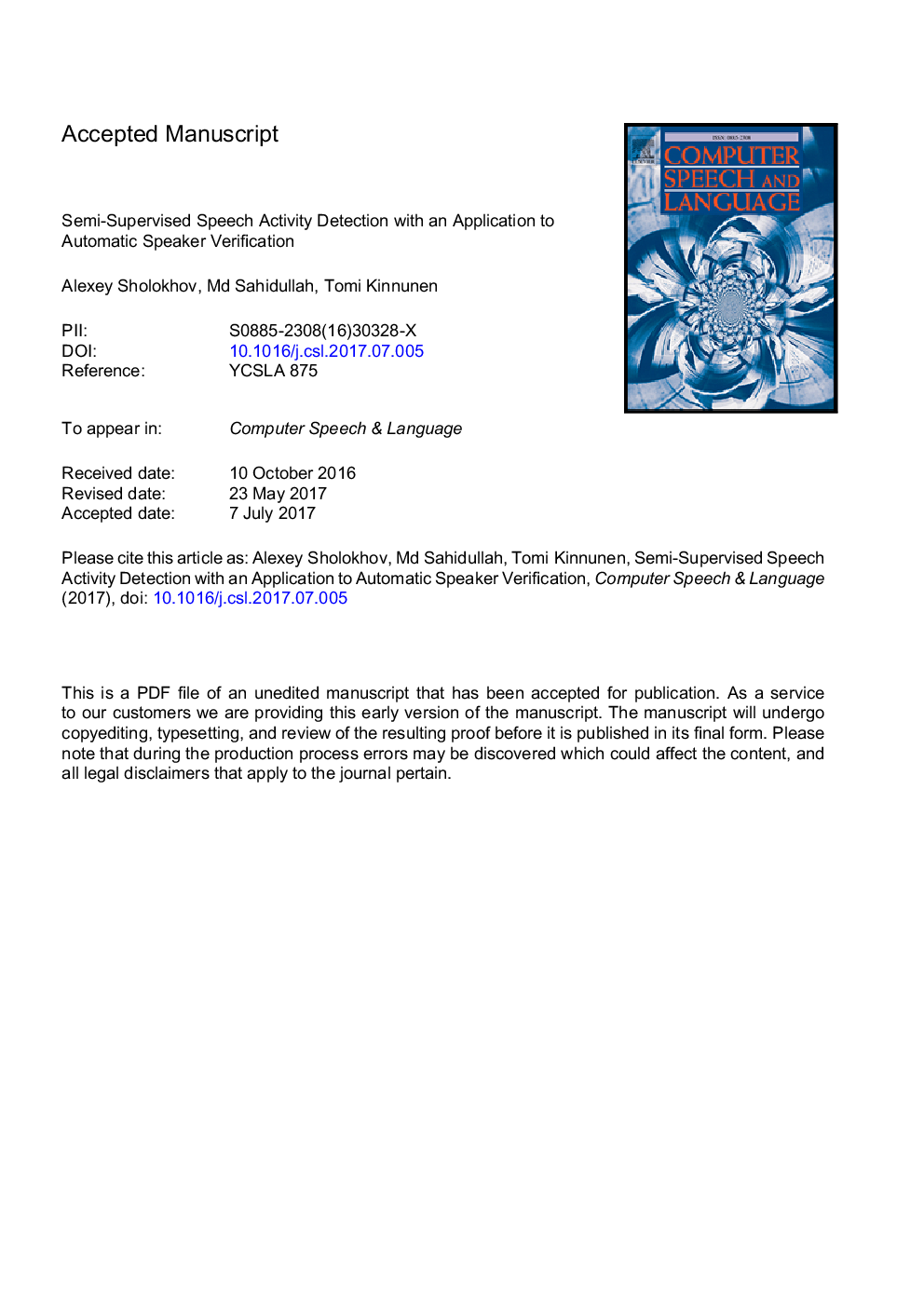| کد مقاله | کد نشریه | سال انتشار | مقاله انگلیسی | نسخه تمام متن |
|---|---|---|---|---|
| 4973643 | 1451680 | 2018 | 50 صفحه PDF | دانلود رایگان |
عنوان انگلیسی مقاله ISI
Semi-supervised speech activity detection with an application to automatic speaker verification
ترجمه فارسی عنوان
تشخیص فعالیت های گفتاری نیمه نظارتی با یک اپلیکیشن برای تایید خودکار سخنران
دانلود مقاله + سفارش ترجمه
دانلود مقاله ISI انگلیسی
رایگان برای ایرانیان
کلمات کلیدی
تشخیص فعالیت سخنرانی؛ یادگیری نیمه نظارتی؛ مدل مخلوط گوسی؛ تشخیص صدا؛ NIST OpenSAD؛ NIST SRE
موضوعات مرتبط
مهندسی و علوم پایه
مهندسی کامپیوتر
پردازش سیگنال
چکیده انگلیسی
We propose a simple speech activity detector (SAD) based on recording-specific Gaussian mixture modeling (GMM) of speech and non-speech frames. We extend the conventional expectation-maximization (EM) algorithm for GMM training using semi-supervised learning. It provides a methodology to incorporate unlabeled data into the SAD training process, leading to more accurate statistical models by exploiting the structure of data distribution. It fits naturally to off-line applications that may require partial human assistance, or applications that involve processing large quantities of audio data, such as text-independent speaker verification, speaker diarization or audio surveillance. The proposed SAD does not require any off-line training data as supervised SADs do. Rather, it employs initial labels produced from a tiny fraction of a given audio recording with the help of another simpler SAD (or a human operator). The proposed SAD is analyzed for the different covariance types, the initialization methods for speech and non-speech class, the amount of labeled data required for initialization, and the speech features. In experiments with a stand-alone SAD system, we observe increased accuracy on the challenging dataset from the recent NIST OpenSAD evaluation. Our extensive automatic speaker verification (ASV) experiments, including text-independent experiments with NIST 2010 speaker recognition evaluation (SRE) data and text-dependent experiments with RSR2015 and RedDots corpora, show benefits of the new approach for the long speech segments containing non-stationary noise. For the shorter data conditions in the text-dependent experiments, simpler unsupervised SADs perform however better. Further, we study the impact of SAD misses and false alarms to ASV performance on the NIST 2010 SRE data. By deriving an empirical cost function with the two SAD errors, we have observed that ASV error rate reaches a minimum value around the same SAD operating point irrespective of SAD method and signal-to-noise ratio (SNR). The optimum ASV performance occurs approximately at an SAD operating region where falsely included non-speech is considered 4-5 times more costly than missed speech. Importantly, the proposed semi-supervised SAD is relatively less dependent on the SAD decision threshold compared to the other contrastive SAD methods.
ناشر
Database: Elsevier - ScienceDirect (ساینس دایرکت)
Journal: Computer Speech & Language - Volume 47, January 2018, Pages 132-156
Journal: Computer Speech & Language - Volume 47, January 2018, Pages 132-156
نویسندگان
Alexey Sholokhov, Md Sahidullah, Tomi Kinnunen,
